Score: 10
Personal Score: 10
*DISCLAIMER*
This review is based on the Gamecube release of Twilight Princess. The Wii Version is discussed at the end of this entry.
Twilight Princess was simultaneously the swan song of the Gamecube and the first Zelda game to hit the Wii. Much like The Wind Waker before it, Twilight Princess generated a massive hype storm prior to its release. Many fans were happy to see Link return to a more photo-realistic Hyrule akin to Ocarina of Time and Majora’s mask, as opposed to the cel-shaded visuals used in The Wind Waker and Four Swords Adventure. With numerous comparisons to Ocarina of Time being drawn, expectations for Twilight Princess were understandably high. Upon its release, Twilight Princess was praised universally, on both the Wii and the Gamecube. For the first time since The Wind Waker, a Zelda game was subject to staggeringly positive reviews and showered with love in the fan community. The graphics were beautiful, the story and characters were brilliant, and the gameplay was rock-solid in standard Zelda fashion. In a departure for the franchise, Twilight Princess presented its story in a decidedly cinematic fashion and featured complex characters/subplots throughout. There were even whispers in the review and fan community that Twilight Princess had topped Ocarina of Time for the coveted ‘Best Zelda Game Evah.’
Over time, the unabashed love for Twilight Princess has faded somewhat, and points of contention have become more prevalent among Zelda fans. Twilight Princess is criticized for much of what makes it similar to Ocarina of Time. It is among the most linear of the Zelda games, and only encourages players to explore Hyrule in small doses. While many fans were happy to see Twilight Princess abandon the cel-shading of The Wind Waker, others were disappointed that the land of Hyrule had become drab and colorless when compared to its predecessor. In regards to the Wii version, many fans felt the motion-controls felt tacked-on and unwieldy. Lastly, many felt that some of the story elements were constricted in order to conform with Zelda traditions (MANY gamers feel that Ganondorf hijacked the game from Zant, who starts out as a fully respectable villain in his own right).
When I first played Twilight Princess, I was not impressed. I was still flying high off of another play-through of The Wind Waker, and consequently judged Twilight Princess with heavily biased eyes. Every moment of my initial play-through was accompanied with negative thoughts of “that’s not how it was in The Wind Waker…I’m not sure I like that.” If I were to have given TP a score following my first completion, I would have given it a very unfair score. Time passed and I re-approached the game with a more open mind, free of the biases that accompanied my first play-through. Thankfully, it was like playing it for the first time. While not my absolute favorite Zelda game, Twilight Princess stands as a beacon of untouchable quality in my eyes. The story is exemplary when compared to the rest of the Zelda games, the graphics paint a melancholy atmosphere that lends itself to the narrative, and the gameplay mechanics are outstanding. Twilight Princess is the crowning achievement in The Legend of Zelda franchise, and is the standard by which all other Zelda games should be compared.
THE PROS:
Where to begin…?
Twilight Princess takes place in the ‘Child Link’ timeline. Hyrule is largely unchanged from Ocarina of Time, a sprawling landscape of varying geographical specifications. The Hyrule of Twilight Princess is indeed one of the most intricately crafted overworlds ever seen in the Zelda franchise. Hyrule castle is the center of it all and the stage for some of the best moments in the game. Castle City appears to be a busier, more populated place in Twilight Princess, and gives the locale a more RPG-type feel with numerous NPCs to talk to (or ignore). Kakariko Village is another familiar place with a personality of its own. While Castle City seems upscale and busy, Kakariko Village is homely and quiet. Like Castle City, Kakariko Village is populated by a colorful group of natives, all of whom are a delight to interact with. More so than any other Zelda game, Twilight Princess makes Hyrule a place that feels complete. When you leave Castle City or Kakariko Village, it’s easy to believe that their respective denizens are continuing to go about their lives instead of just waiting for Link to return. While the overworlds of The Wind Waker and Skyward Sword feel fragmented, Twilight Princess offers players a world that feels connected and cohesive.
Outside of the two major hubs, Hyrule is made up of a variety of strange and fascinating locales. Scattered across the landscape are sprawling plains, dark forests, treacherous mountains, harsh deserts, and dilapidated ruins. Many of these places feel ripped out of the ‘build your own adventure story’ handbook, but Nintendo crafted each locale with such detail and grandiosity that you replace any feelings of familiarity with wonder and excitement. When faced with exploring this sweeping landscape and all its various mysteries, it feels as if you’re taking part in a genuine adventure. Fear, excitement, awe, and wonder are all emotions I frequently felt when exploring the land of Hyrule in Twilight Princess. The dungeon layouts are equally impressive. The temples are standard Zelda fare. You get a forested temple, a fiery temple, a wet temple, a dry temple, a frozen temple, and a celestial/divine/whatever temple (I’m noticing pattern in my reviews…). What sets them apart from other Zelda temples is the intimidating, sinister atmosphere of the Twilight Princess temples. Not since Ocarina of Time and Majora’s Mask have Zelda temples felt so malevolently creepy throughout. A sense of dread hangs in the air of each temple as you attempt to navigate the dark corridors. Majora’s Mask is often cited for its darker, macabre atmosphere, and Twilight Princess gives MM a run for its money in that department.
The land of Hyrule is the stage for some of the best storytelling in the franchise’s history. Hyrule is beset by a malicious blanket of Twilight, brought forth by the insane despot of a twisted world. Having no choice but to surrender her castle to Zant, princess Zelda is forced into house arrest as she watches her kingdom fall into perpetual twilight. Link is captured while minding his own business in his home village and is changed into a wolf after exposure to the encroaching twilight. Rescued by Midna (who is the titular character, transformed into an imp by Zant), Link must traverse Hyrule in search of a way to return Hyrule to normal and put an end to Zant (and, it turns out, Ganondorf). The length of this blog would certainly suffer from too much detail regarding the plot and various subplots, but what unfolds is a fascinating narrative full of surprises and complex character development.
Most of the core cast of characters in Twilight Princess standout as some the most complex in Zelda history. Within the Zelda fan community, it’s almost a cliched notion to talk about Midna, given how often she’s cited as one of the most intricately presented characters in the franchise. Midna acts as Link’s companion in TP, but is a stark contrast to what fans had come to expect from the winged chatterboxes normally following Link around. Throughout the beginning of the game, Midna is creepy, self-serving, manipulative and speaks with a sardonic sense of dismissal of Link and the land of Hyrule. She takes visible pleasure in watching Link attempt to navigate twilit Hyrule as a wolf in clumsy fashion. While this behavior could have garnered some intense dislike, Midna rarely comes across as malevolent, and is endearing in her very unique, eerie way. We even get a glimpse of some implied mental instability following her exile from the Twilight Realm (in one of the best cutscenes in all of video game history). As the story progresses, Midna shows her true colors when her motivations are revealed and adopts a less mocking attitude. Where she was sarcastic and dismissive in the beginning, she becomes driven and sympathetic to the plight of Hyrule, thanks to the selflessness of Link and Zelda (again, complex stuff that would make this review WAY too long). At the end of the game, after her curse has been lifted, we see that Midna is every bit the regal princess that Zelda is. It’s truly a shame that we haven’t seen hide nor hair of Midna since Twilight Princess. It is my genuine belief that Midna deserves another appearance in the Zelda series, one that I will continue to wait for with escalating anticipation.
One of the weirdest pairs in video games, and one of the best. Bring ’em back, Nintendo!
Princess Zelda again plays the role of ‘damsel in distress,’ albeit a little differently this time around. Zelda was not captured by Zant or Ganon through conniving treachery and stored away. Instead, she willingly gives Zant control of Hyrule in order to avoid bloodshed in her kingdom. In one of the early cutscenes, we see a downright intimidating-looking Zelda preparing to cross blades with the twilit intruders, not cowering behind sages or praying for safety. Historically, Zelda has been largely helpless in the face of danger and is quick to cry out for help when threatened. Twilight Princess Zelda is a mature, regal figurehead who commands respect. She only remains locked away in her tower for fear that Zant will bring ruin to her people. Given different circumstances, it’s easy to believe that Zelda would have cut Zant and his followers to ribbons (and oh how I wish we could have seen that happen). While we don’t get to see much of this Zelda , she remains an important part of the story throughout.
To wrap up my examination of the characters, I’d like to touch on Ganondorf. While Ganondorf in The Wind Waker was given more complex motivations and a deeper emotional presentation, Twilight Princess Ganondorf returns as the purely evil and powerful fiend we fought in Ocarina of Time. Ganondorf is presented in a decidedly more frightening manner this time around, displaying terrible power and ruthlessness. He’s intimidating, powerful, malicious, and driven by a single-minded thirst for power and destruction. While not overly complex or standout as a character, Ganondorf embodies the idea of ‘The King of Evil’ perfectly in Twilight Princess. The final fight with Ganondorf is a dream come true for Zelda fans that wanted Link and Ganondorf to engage in a true sword-fight, mano a mano.
The gameplay department in Twilight Princess builds off of the mechanics introduced in The Wind Waker and improves upon them. Link navigates the landscape of Hyrule with the familiar ease we’ve come to expect from a Zelda game. Epona makes her return, and galloping about the landscape is as fluid and comfortable as one could hope for. You even have the option of JUMPING onto Epona and starting off at a gallop. Awesome. Combat is also improved in Twilight Princess. The counter system in WW has been replaced by the need to hunt for hidden skills taught to Link by a ghost of Hyrule’s past (no spoilers from me, but you should look that up if you’re curious). While this can be a bit irksome, knowing that the sweet-ass counter moves you used in The Wind Waker must be acquired in Twilight Princess before you can use them, it adds a sense of accomplishment to exploring the landscape and a layer of sense to why Link is such a good swordsman. Additionally, Twilight Princess adds new skills Link can use in combat that weren’t available in The Wind Waker. You can finish the game without ever having acquired any of the hidden skills, but you’ll be a much more versatile and effective combatant if you take the time to find them.
I’ll wrap up the ‘PROS’ section with the enemies of Hyrule. I mentioned previously how intimidating the dungeons are, and part of that has to do with how sinister the enemies of Twilight Princess are. Lizalfos, Bokoblin, Bulbins, Shadow Beasts, Stalfos and Poes all look decidedly more intimidating and threatening than the bright and colorful enemies of The Wind Waker and Phantom Hourglass. Simply put, they look like BAD GUYS. Fighting the various beasts in Twilight Princess conjured feelings of fear and anxiety I hadn’t felt since I was a kid playing Ocarina of Time for the first time. Death Sword may go down as one of the most frighteningly sinister mini-bosses in Zelda history. This makes defeating even the smallest of enemies a satisfying experience (made even more so when following an encounter, Link adds a badass flourish before sheathing his blade). Encounters with Darknuts in Twilight Princess feel like genuine sword-fights between two warriors, and are among the most exciting and brilliant fights to engage in. The boss fights of Twilight Princess are no slouches either. Again, we see Nintendo returning to the intimidating, evil-looking beasts we saw in Ocarina of Time and Majora’s Mask. While most of the bosses in Twilight Princess go down after a few telegraphed patterns using the shiny new item you just acquired, the encounters still feel larger than life and maintain the grand spectacle introduced in The Wind Waker. In terms of satisfying experience, Twilight Princess is rivaled only by a few other games in the series for best boss fights.
Yeah, the fight with this guy is as badass as you’d think it’d be.
THE CONS:
While it might seem like I have nothing but good things to say about Twilight Princess, a few things stand out as less-than-stellar.
My first point of contention is one that seems to be shared by many gamers; the game is VERY linear. This is, unfortunately, one of the downsides to having a high-quality narrative. Twilight Princess often restricts your gameplay options in order to move the narrative along. While this makes for an engrossing and involved experience, it does make it difficult to return to Twilight Princess for subsequent playthroughs, knowing you wouldn’t be able to do whatever you want right out of the gate. True, there is a lot of exploring to be done in Hyrule, but most of it must wait until the core narrative has all but completed and you leave Hyrule Castle to do some backtracking. The best way to avoid excess frustration is to either take extended breaks from the game following a full playthrough, or keep an extra save file that you can return to when you just want to roam around Hyrule at the end of the game.
In the character department, two things stand out as disappointments in my eyes. First, Link himself. While Link fills the role of steadfast hero well enough, he kinda looks like a mannequin throughout the entirety of the game. The only emotion that looks genuine is the look of determination we see when Link enters a battle or pursuit of an enemy. Everything else looks robotic and poorly animated. Following the expressiveness of The Wind Waker Link, Twilight Princess Link is a letdown. This disappointment is amplified by the fact that everyone around Link, including NPCs, exude ample amounts of personality and expressiveness.
I am Link, the master compartmentalizer with the expressiveness of a sociopath!
Lastly, I want to touch on Zant. There’s a bit of a divide in the Zelda community regarding Zant’s role in Twilight Princess. Many felt that Zant was a brilliant villain that could have carried the story to its conclusion without the help of Ganondorf. Others felt that he started out as a good villain, and then devolved into a cackling lunatic who couldn’t be taken seriously. I myself hold a bit of both those opinions as my own. I believe Zant started out as a fantastic villain, emanating a Sith-like presence and displaying terrible power. I thought he was brilliant and intimidating throughout the majority of the game. However, I was surprised to see him turn into a child throwing a tantrum during the final encounter with him. He had displayed such cold, dismissive indifference throughout the rest of the game, so where was this nonsense coming from? His behavior is explained as an emotional reaction to not being given a high standing in the Twilight Realm’s royal court. He could have remained an emotionless despot-type figure right up to his demise at the hands of Midna, but Nintendo made the decision to give him a more distinct and unstable demeanor in his final moments. While this makes him a difficult villain to like (in the way people like Darth Vader), it’s a writing decision made by Nintendo that allows Zant to stand out amongst the rest of the series’ villains.
I am of the camp that believes Ganondorf was not responsible for hijacking the game from Zant. Zant’s startling power is explained nicely through his bargain with Ganondorf, and Ganondorf is an integral part of the Zelda lore. Because Link, Zelda and Ganondorf are fated to be linked as long as the Triforce exists, discluding him would have been a crime in my eyes. What I would have been a nice twist in the narrative would have been to see Zant and Ganondorf fighting for control of Hyrule once Ganondorf regained his full strength. Instead, Nintendo decided to lower Zant to the pathetic status of puppet villain, which undermines his whole character throughout the beginning of the game.
Zant: Simultaneously one of the best and worst villains in The Legend of Zelda
At this point in time, Twilight Princess occupies an odd spot in the minds of the fan community. It’s been almost seven years since it initially released, but it hasn’t exactly garnered ‘classic’ status as of yet. At the same time, it’s new enough that many gamers see it as ‘the game that came out before Skyward Sword.’ On various gaming sites, Twilight Princess is largely ignored on ‘Top Ten’ lists. I believe that many people are hesitant to show TP any love because it is sometimes seen as Nintendo’s effort to satisfy fan’s demands for an Ocarina of Time carbon-copy Zelda. It’s not exactly ‘Zelda Chic’ to say you like an entry in the series because it’s ‘darker’ or ‘more mature.’ Of course, this is an unforgivable dismissal of what makes Twilight Princess so great. If you put down on paper what makes a Zelda game mechanically great by building off the groundwork laid by Ocarina of Time, Twilight Princess is the definitive Zelda experience. In terms of crafting a sublime gaming experience and penning a marvelous narrative with complex characters, Twilight Princess stands at least a head above what was done before or after. With a new Zelda game on the horizon for the Wii U, my expectations are very, very high. Not because of what Skyward Sword was able to accomplish in the gameplay department, or what Majora’s Mask was able to do in the storytelling department; but because of what Twilight Princess did on both levels. There’s an impossibly high bar that Nintendo must vault when they make a new Zelda game, and the name that is etched in the highest spot of that bar is ‘Twilight Princess.’
Gamecube VS Wii:
This review is based on the Gamecube release, which I believe is superior. I played through both versions in their entirety, and every moment I played the Wii version was accompanied with a groan of “ugh, this waggling is ridiculous.” I was still able to enjoy the game, but I definitely preferred having a Gamecube controller in my hand as opposed to the Wii-Mote. The motion controls of Skyward Sword blow TPs motion controls out the water and into obsolete space. Also, the nerd in me was a little miffed that Link was right-handed in the Wii version. Yeah, that’s a little bit ‘Han Shot First’ of me, but I have no shame. Thpt.
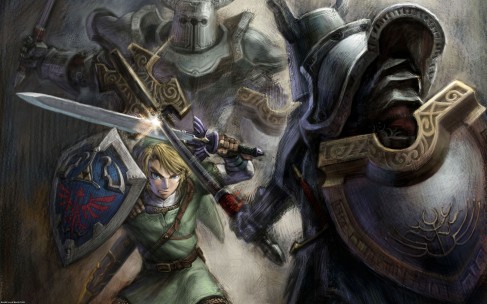
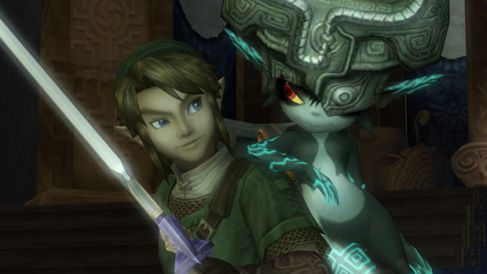
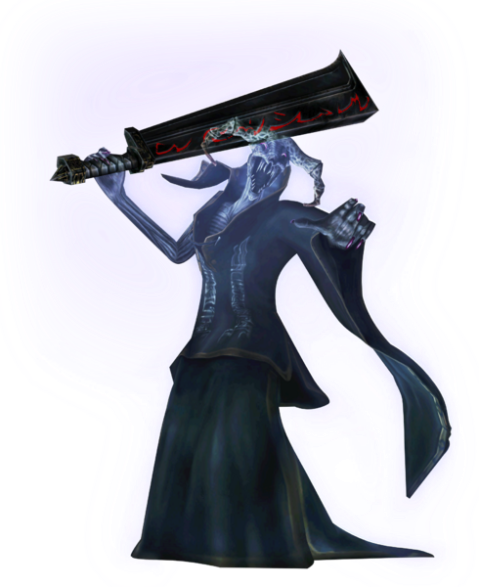
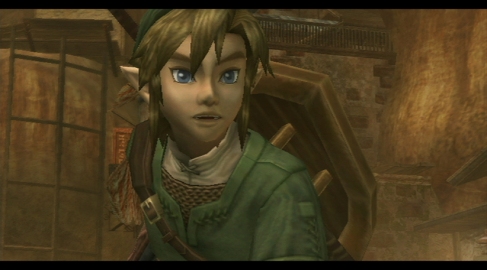
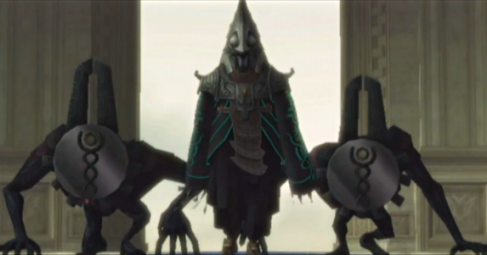





 She looks pretty tough in that armor…but watch out for mice. Mice will MESS YOU UP, girl.
She looks pretty tough in that armor…but watch out for mice. Mice will MESS YOU UP, girl.


